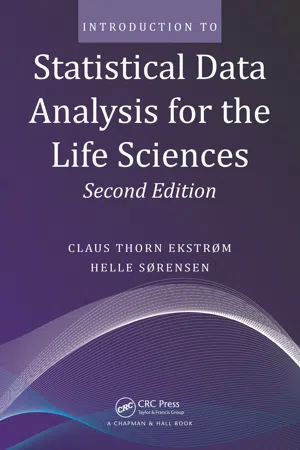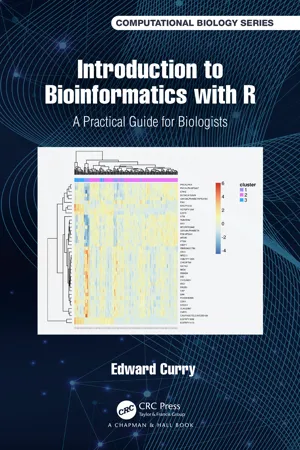Biological Sciences
Statistical Analysis in Biology
Statistical analysis in biology involves the application of statistical methods to biological data in order to draw meaningful conclusions. It encompasses techniques such as hypothesis testing, regression analysis, and experimental design to analyze and interpret biological phenomena. This approach is crucial for understanding complex biological processes, identifying patterns, and making informed decisions in biological research.
Written by Perlego with AI-assistance
Related key terms
1 of 5
3 Key excerpts on "Statistical Analysis in Biology"
- Claus Thorn Ekstrom, Helle Sørensen(Authors)
- 2014(Publication Date)
- Chapman and Hall/CRC(Publisher)
Chapter 14 Statistical analysis examples This chapter presents examples of complete and detailed analyses of various datasets. The presentation of the full-fledged analyses is meant as inspiration and can form the basis for a discussion on how to undertake, summarize, and report a statistical analysis. The primary focus will be on the statistical analyses and on how to state the conclusions, and less attention will be given to descriptive statistics. The process of investigating a biological hypothesis can be envisioned as shown in Figure 14.1. A biological hypothesis is proposed and we wish to investigate it in order to reach a conclusion. This is done by rephrasing the biological hypothesis as a mathematical/statistical hypothesis, building a statistical model and drawing conclusions based on the estimates and infer-ence from that model. Finally, the results from the statistical analysis should be translated back such that any conclusions are phrased in biological terms. Biological hypothesis Statistical hypothesis Biological conclusion Statistical conclusion Figure 14.1: The process of investigating a biological hypothesis in order to reach a biological conclusion through the use of statistics. Usually the following steps are part of a statistical analysis: 1. Propose an initial model based on the biological hypothesis and any prior information about the problem and the design of the experiment. 2. Validate the model assumptions. If the assumptions are not fulfilled then a new model has to be proposed and validated. 387 388 Introduction to Statistical Data Analysis for the Life Sciences 3. Simplify the model to obtain as simple a model as possible that de-scribes the data. 4. Obtain parameter estimates (and their corresponding standard errors) from the final model. 5. Report conclusions based on final model. Depending on the problem not all steps may be relevant in all situations.- eBook - ePub
Introduction to Bioinformatics with R
A Practical Guide for Biologists
- Edward Curry(Author)
- 2020(Publication Date)
- Chapman and Hall/CRC(Publisher)
4 Statistical Methods for Data AnalysisIn this chapter we will try to get a good understanding of some analytical tools that will empower you to use datasets to answer real-world questions. You will see how some of the programming tricks can be used with R’s built-in number-handling functions to put the theory into a practical context.We start with an illustration of why we use statistical methods in research, to introduce the theory of probabilities, then describe some methods that use probabilities to help us attach confidence to observations in data.4.1What are statistical methods, and why do we use them in biological research?In applying statistical methods to data analysis, we are typically aiming to describe some properties of the data, or we wish to infer properties of what the data represent. I find the distinction between these aims quite revealing about why statistical methods are important in biological research. It should be intuitive that descriptive statistics are useful: these are the means of characterizing or summarizing properties of the data we have collected. But assuming we undertake research according to a traditional scientific method, we can advance knowledge through testing hypotheses: we use data to help us determine whether a hypothesis is supported by observation or should be rejected.Because it is rarely possible to obtain perfectly accurate measurements, nor to have complete control over all potential sources of variation in the systems being measured, we have to consider the fact that if we obtained more data, it probably wouldn’t be the same as the data we already have. The measurements we have are just representatives (this is a sample) of all such measurements that could have been obtained, if we had repeated the experiment infinitely (this is a population). We use statistical inference to estimate properties of that infinite set of all measurements that could have been obtained, by modelling these uncontrolled variations in the data as randomness - eBook - PDF
The Practical Researcher
A Student Guide to Conducting Psychological Research
- Dana S. Dunn(Author)
- 2012(Publication Date)
- Wiley-Blackwell(Publisher)
The academic discipline of statis- tics concerns itself with the collection, classification, analysis, and interpretation of such numerical information. In the field of psychology, statistical analyses are used to interpret the results of experiments and applied or field studies. Whether the term is used to refer to specific analyses or particular results, statistics are not as important as the variables or psychological phenomena they help to explain. Instead, they are useful 250 Chapter 8: Planning Analysis and Displaying Data tools—the means that allow researchers to accomplish their tasks and to make sense out of research on behavior. If you have not yet taken a statistics course, you should do so at your earliest oppor- tunity. There is no adequate substitute for taking a statistics course either in or outside the field of psychology. Properly taught, statistics should introduce you to new ways to think about the world, including how to predict events and isolate biases in it. Most statistical analyses do not entail a great deal of math, especially if you focus on the inherent logic behind quantifying relationships among variables and remember the role of some frequently used Greek symbols (which are only stand-ins for simple, familiar mathematical functions). In my experience, many “statistics shy” students can have an “is that all there really is to it?” sort of experience if they approach analyses with dili- gence, effort, and an open mind (see Research Foundations Box 8.1). Please be aware that I am not going to teach you to actually calculate any statistical tests in this chapter; rather, my purpose here is to convey information designed to help you choose the right statistical test. Some basic statistical tests will be presented, but only in brief, conceptual discussions (Appendix B contains directions for performing their calculations).
Index pages curate the most relevant extracts from our library of academic textbooks. They’ve been created using an in-house natural language model (NLM), each adding context and meaning to key research topics.


